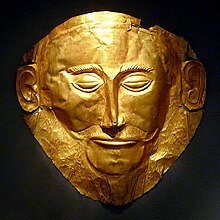gamemnon is set in the city of Argos, Greece. Argos lies on the fertile Argolid plain in the eastern Peloponnese in Greece. The site has been inhabited from prehistoric times up to the present day. Ancient Argos was built on two hills: Aspis and Larissa, 80 m and 289 m in height respectively. Argos, along with Mycenae and Tiryns, was a significant Mycenaean centre, and the city remained important throughout the Greek, Hellenistic, and Roman periods until its destruction by the Visigoths in 395 CE.
In ancient Greek mythology, the city gained its name from Argos, son of Zeus and Niobe. Homer’s Iliad tells of Argos sending men to fight in the Trojan War, as being ruled by Agamemnon, and as a place celebrated for its horse rearing. The city is also described by Homer as being especially dear to the goddess Hera. (Source: Ancient History Encyclopedia)

About Agamemnon, a play within The Oresteia (trilogy)
Read the play online (Gutenberg)
The Oresteia (Ancient Greek: Ὀρέστεια) is a trilogy of Greek tragedies written by Aeschylus concerning the murder of Agamemnon by Clytaemnestra, the murder of Clytaemnestra by Orestes, the trial of Orestes, the end of the curse on the House of Atreus and pacification of the Erinyes. The trilogy—consisting of Agamemnon (Ἀγαμέμνων), The Libation Bearers (Χοηφóρoι), and The Eumenides (Εὐμενίδες)—also shows how the Greek gods interacted with the characters and influenced their decisions pertaining to events and disputes.[1] The only extant example of an ancient Greek theatre trilogy, the Oresteia won first prize at the Dionysia festival in 458 BC. Many consider the Oresteia to be Aeschylus' finest work. The principal themes of the trilogy include the contrast between revenge and justice, as well as the transition from personal vendetta to organized litigation.[2] Orestia originally included a satyr play, Proteus (Πρωτεύς), following the tragic trilogy, but all except a single line of Proteus has been lost. (Source: Wikipedia)
Agamemnon (Ἀγαμέμνων, Agamémnōn) is the first of the three plays within the Oresteia trilogy. It details the homecoming of Agamemnon, King of Mycenae, from the Trojan War. After ten years of warfare, Troy had fallen and all of Greece could lay claim to victory. Waiting at home for Agamemnon is his wife, Queen Clytemnestra, who has been planning his murder. She desires his death to avenge the sacrifice of her daughter Iphigenia, to exterminate the only thing hindering her from commandeering the crown, and finally be able to publicly embrace her long-time-lover Aegisthus.[3]

The murder of Agamemnon, from an 1879 illustration from Stories from the Greek Tragedians by Alfred Church
The main characters in Agamemnon are:
- Agamemnon: Son of Atreus, King of the Argos.
- Clytaemnestra: Daughter of Tyndareus, sister of Helen, and wife of Agamemnon.
- Cassandra: Sister of Paris; daughter of Priam, King of Troy.
- The Chorus : A group of elderly citizens of Argos.
- Aegisthus : Clytemnestra's lover and accomplice, and Agamemnon's cousin.

Source: The Oresteia
About Agamemnon, the character in Greek mythology

The Mask of Agamemnon which was discovered by Heinrich Schliemann in 1876 at Mycenae, now believed to pre-date the legendary Trojan War by 300 years
In Greek mythology, Agamemnon (/æɡəˈmɛmnɒn/; Greek: Ἀγαμέμνων from *Ἀγαμέδμων [from ἄγαν, "very much" and μέδομαι, "think on"],[1] "very steadfast", "unbowed") was the son of King Atreus and Queen Aerope of Mycenae, the brother of Menelaus, the husband of Clytemnestra and the father of Iphigenia, Electra or Laodike (Λαοδίκη), Orestes and Chrysothemis.[2] Legends make him the king of Mycenae or Argos, thought to be different names for the same area.[3] When Helen, the wife of Menelaus, was taken to Troy by Paris, Agamemnon commanded the united Greek armed forces in the ensuing Trojan War.
Upon Agamemnon's return from Troy, he was murdered (according to the oldest surviving account, Odyssey 11.409–11) by Aegisthus, the lover of his wife, Clytemnestra. In old versions of the story, the scene of the murder, when it is specified, is usually the house of Aegisthus, who has not taken up residence in Agamemnon's palace, and it involves an ambush and the deaths of Agamemnon's followers as well.[4] In some later versions Clytemnestra herself does the killing, or they act together as accomplices, killing Agamemnon in his own home. (Read the rest on Wikipedia)
About Aeschlylus
Aeschlylus 525 BCE – 456 BCE
“Aeschylus [is] the earliest Greek tragic poet whose work survives. Born at Eleusis, near Athens, of a noble family, he witnessed in his youth the end of tyranny at Athens, and in his maturity the growth of democracy. He took part in the Persian Wars, at the battle of Marathon in 490 (where his brother was killed) and probably at Salamis in 480 (which he describes in the Persians). At some time in his life he was prosecuted, it was said, on the charge of divulging the Eleusinian mysteries, but exculpated himself. He visited Syracuse at the invitation of the tyrant Hieron I more than once and died at Gela in Sicily; an anecdote relates that an eagle dropped a tortoise on his bald head and killed him. Soon after his death it was decreed as a unique honour that anyone who wished to produce his plays should be ‘granted a chorus.’ He had a son, Euphorion, like himself a tragic poet. (Read mroe at the souce:Columbia University)